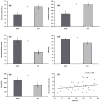Sickle cell disease: selected aspects of pathophysiology
- PMID: 20364061
- PMCID: PMC2910781
- DOI: 10.3233/CH-2010-1270
Sickle cell disease: selected aspects of pathophysiology
Abstract
Sickle cell disease (SCD), a genetically-determined pathology due to an amino acid substitution (i.e., valine for glutamic acid) on the beta-chain of hemoglobin, is characterized by abnormal blood rheology and periods of painful vascular occlusive crises. Sickle cell trait (SCT) is a typically benign variant in which only one beta chain is affected by the mutation. Although both SCD and SCT have been the subject of numerous studies, information related to neurological function and transfusion therapy is still incomplete: an overview of these areas is presented. An initial section provides pertinent background information on the pathology and clinical significance of these diseases. The roles of three factors in the clinical manifestations of the diseases are then discussed: hypoxia, autonomic nervous system regulation and blood rheology. The possibility of a causal relationship between these three factors and sudden death is also examined. It is concluded that further studies in these specific areas are warranted. It is anticipated that the outcome of such research is likely to provide valuable insights into the pathophysiology of SCD and SCT and will lead to improved clinical management and enhanced quality of life.
Figures





Similar articles
-
Common α-globin variants modify hematologic and other clinical phenotypes in sickle cell trait and disease.PLoS Genet. 2018 Mar 28;14(3):e1007293. doi: 10.1371/journal.pgen.1007293. eCollection 2018 Mar. PLoS Genet. 2018. PMID: 29590102 Free PMC article.
-
Blood rheology abnormalities and vascular cell adhesion mechanisms in sickle cell trait carriers during exercise.Clin Hemorheol Microcirc. 2008;39(1-4):179-84. Clin Hemorheol Microcirc. 2008. PMID: 18503123 Review.
-
Autonomic nervous system dysfunction: implication in sickle cell disease.C R Biol. 2013 Mar;336(3):142-7. doi: 10.1016/j.crvi.2012.09.003. Epub 2012 Oct 16. C R Biol. 2013. PMID: 23643396 Review.
-
Blood rheology and vascular function in sickle cell trait and sickle cell disease: From pathophysiological mechanisms to clinical usefulness.Clin Hemorheol Microcirc. 2024;86(1-2):9-27. doi: 10.3233/CH-238122. Clin Hemorheol Microcirc. 2024. PMID: 38073384 Review.
-
The role of blood rheology in sickle cell disease.Blood Rev. 2016 Mar;30(2):111-8. doi: 10.1016/j.blre.2015.08.005. Epub 2015 Aug 28. Blood Rev. 2016. PMID: 26341565 Free PMC article. Review.
Cited by
-
Antibiotics for treating osteomyelitis in people with sickle cell disease.Cochrane Database Syst Rev. 2019 Oct 7;10(10):CD007175. doi: 10.1002/14651858.CD007175.pub5. Cochrane Database Syst Rev. 2019. PMID: 31588556 Free PMC article. Review.
-
Respiratory resistance and reactance in adults with sickle cell anemia: Correlation with functional exercise capacity and diagnostic use.PLoS One. 2017 Dec 8;12(12):e0187833. doi: 10.1371/journal.pone.0187833. eCollection 2017. PLoS One. 2017. PMID: 29220407 Free PMC article.
-
Relationships between systemic vascular resistance, blood rheology and nitric oxide in children with sickle cell anemia or sickle cell-hemoglobin C disease.Clin Hemorheol Microcirc. 2014;58(2):307-16. doi: 10.3233/CH-121661. Clin Hemorheol Microcirc. 2014. PMID: 23302597 Free PMC article.
-
Autonomic and Vascular Responses during Reactive Hyperemia in Healthy Individuals and Patients with Sickle Cell Anemia.Medicina (Kaunas). 2023 Jun 13;59(6):1141. doi: 10.3390/medicina59061141. Medicina (Kaunas). 2023. PMID: 37374344 Free PMC article.
-
Blood rheology and aging.J Geriatr Cardiol. 2013 Sep;10(3):291-301. doi: 10.3969/j.issn.1671-5411.2013.03.010. J Geriatr Cardiol. 2013. PMID: 24133519 Free PMC article. Review.
References
-
- Adams RJ, McKie VC, Hsu L, et al. Prevention of a first stroke by transfusions in children with sickle cell anemia and abnormal results on transcranial Doppler ultrasonography. N Engl J Med. 1998;339:5–11. - PubMed
-
- Alexy T, Wenby RB, Pais E, et al. An automated tube-type blood viscometer: validation studies. Biorheology. 2005;42:237–247. - PubMed
-
- Alexy T, Pais E, Armstrong JK, Meiselman HJ, Johnson CS, Fisher TC. Rheologic behaviour of sickle and normal red blood cell mixtures in sickle plasma: implications for transfusion therapy. Transfusion. 2006;46:912–918. - PubMed
-
- Ashcroft MT, Desai P. Mortality and morbidity in Jamaican adults with sickle-cell trait and with normal haemoglobin followed up for twelve years. Lancet. 1976;2:784–786. - PubMed
-
- Austin H, Key NS, Benson JM, Lally C, Dowling NF, Whitsett C, Hooper WC. Sickle cell trait and the risk of venous thromboembolism among blacks. Blood. 2007;110:908–912. - PubMed
Publication types
MeSH terms
Grants and funding
- HL090511/HL/NHLBI NIH HHS/United States
- M01 RR000046/RR/NCRR NIH HHS/United States
- U54 HL090511/HL/NHLBI NIH HHS/United States
- HL07180/HL/NHLBI NIH HHS/United States
- U54 HL070595/HL/NHLBI NIH HHS/United States
- T32 HL007180/HL/NHLBI NIH HHS/United States
- R21 HL090451/HL/NHLBI NIH HHS/United States
- R01 HG003956/HG/NHGRI NIH HHS/United States
- HL15722/HL/NHLBI NIH HHS/United States
- MO1 RR00046/RR/NCRR NIH HHS/United States
- HL70595/HL/NHLBI NIH HHS/United States
- R01 HL015722/HL/NHLBI NIH HHS/United States
- EB001978/EB/NIBIB NIH HHS/United States
- HG003956/HG/NHGRI NIH HHS/United States
- HL090451/HL/NHLBI NIH HHS/United States
- P41 EB001978/EB/NIBIB NIH HHS/United States
LinkOut - more resources
Full Text Sources
Medical

